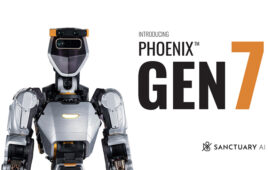|
Listen to this article
|

UC San Diego’s robot has two large flippers to help it move through sand like a sea turtle. | Source: UC San Diego
Researchers at the University of California San Diego have created a robot that can swim under the sand and dig itself out. The robot has two front limbs that mimic the oversized flippers of turtle hatchlings.
Traveling through sand presents many unique challenges for robots. Friction between sand grains leads or large forces for the robot to deal with, much larger than forces present in water or in the air. When the robot is digging under the sand it has no way to sense obstacles ahead of it, which could damage the robot. Sand also sometimes acts like a liquid and sometimes like a solid, presenting additional challenges.
“We needed to build a robot that is both strong and streamlined,” Shivam Chopra, lead author of the paper describing the robot in the journal Advanced Intelligent Systems and a Ph.D. student in the research group of Professor Nick Gravish at the Jacobs School of Engineering at UC San Diego, said.
To overcome all of these difficulties, the UC San Diego research team turned to nature for inspiration. While the team considered modeling its robot after worms, it eventually decided on sea turtle hatchlings, which have enlarged front fins that are particularly useful for digging to the surface after hatching.
So, the team equipped their robot with two turtle-like flippers that can generate large propulsive forces, allowing the robot to steer and have the potential to detect obstacles. After extensive testing and simulations, the UC San Diego team decided to use make the robot using a tapered body design and a shovel-shaped nose.
This turtle-like robot is able to detect obstacles by monitoring changes in the torque generated by the movements of its flippers. It’s best at detecting obstacles above its body, but not below or directly in front of the robot.
The researchers also designed two foil-like surfaces, which they call terrafoils, on the sides of the robot’s nose to keep the robot at level depth in the sand. These terrafoils allow the researchers to control lift, as the team noticed that the robot had a tendency to keep its nose pointed down toward the surface.
The robot was tested in a 5ft long tank in the lab, as well as at La Jolla Shores, a beach near the UC San Diego campus. The robot can travel through sand at a depth of 5 inches and a speed of 1.2 millimeters per second, or roughly 4 meters or 13 feet per hour.
While this may seem slow, it’s a comparable speed to other subterranean animals like worms and clams. The team does, however, hope to speed the robot up in future experiments. The team also hopes to give the robot the ability to burrow into the sand as well as being able to dig itself out.
A robot that can operate in the sand has many potential use cases, like the inspection of grain silos, taking measurements for soil contaminants, seafloor digging, extraterrestrial exploration, and search and rescue.






Tell Us What You Think!